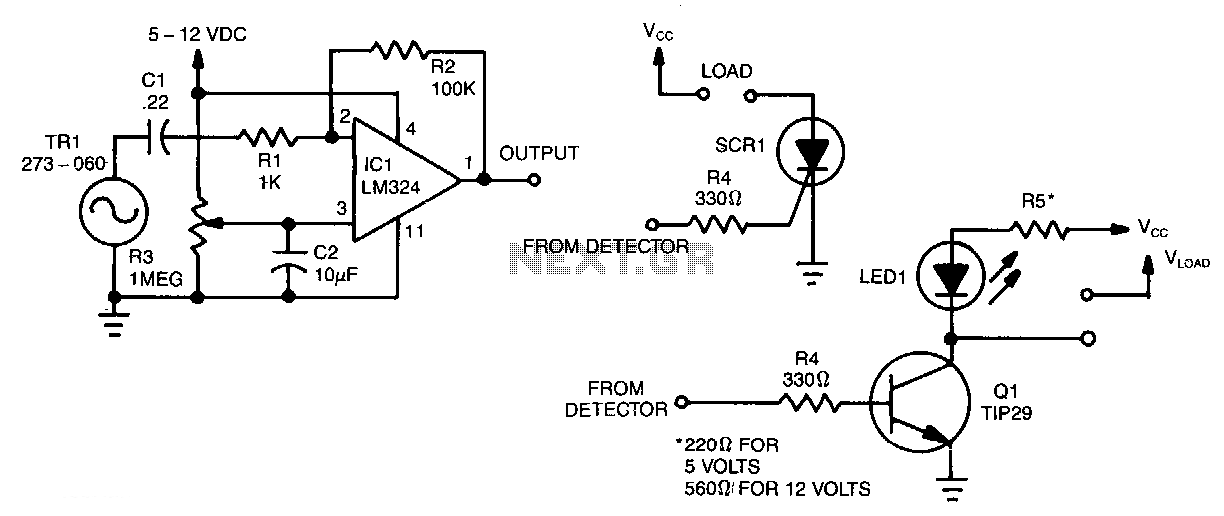
Air-motion-detector

When a current of air strikes the piezo element, a small signal is generated and transmitted through C1 and R1 to the inverting input pin 2 of one section of the LM324. This action causes output pin 1 to increase. Resistor R3 is utilized to adjust the sensitivity of the detector. The circuit can be configured to detect subtle movements, such as the wave of a hand, or set to a threshold where even a strong blow on the element will not produce any output. Resistor R2 is employed to regulate the output voltage level at pin 1. The detector circuit can be applied in various control applications. For instance, an SCR can be used to control 7-VAC loads as demonstrated. Additionally, an NPN transistor, such as a TIP29, can be employed to manage loads as illustrated.
The described circuit utilizes a piezoelectric element to sense variations in air pressure, translating these variations into electrical signals. The piezo element generates a voltage when mechanical stress is applied, which is then conditioned by capacitors and resistors to optimize the signal for further processing. The LM324, a quad operational amplifier, is configured in a comparator mode to amplify the small signals generated by the piezo element. The inverting input (pin 2) receives the conditioned signal, while the non-inverting input can be set to a reference voltage to determine the sensitivity threshold.
Resistor R3 plays a crucial role in determining the sensitivity of the detection circuit, allowing for fine-tuning based on the specific application requirements. A higher resistance value will decrease sensitivity, making it necessary for a stronger signal to trigger the output, while a lower resistance value will increase sensitivity, allowing for the detection of weaker signals.
Resistor R2 is responsible for setting the output voltage level at pin 1 of the LM324. This output can then be used to drive various loads. The circuit can be interfaced with a silicon-controlled rectifier (SCR) for controlling AC loads, which are typically used in applications requiring high power, such as lighting or motor control. The SCR can be triggered by the output of the LM324, allowing for the control of 7-VAC loads effectively.
Alternatively, the output can also drive an NPN transistor, such as the TIP29, which can be used to switch DC loads. The transistor acts as a switch, capable of controlling larger currents than the LM324 output alone could handle. This versatility allows the circuit to be employed in a wide range of applications, from simple hand detection to more complex automation systems, making it a valuable component in electronic control systems.When a current of air hits tbe piezo element, a small signal is generated and is fed through Cl and Rl to inverting input pin 2 of one section of the LM324. That causes output pin 1 to increase. Resistor R3 is used to adjust the sensitivity of the detector. The circuit can be set so high as to detect the wave of a hand or so low that blowing on the element as hard as you can will produce no output.
Resistor R2 is used to adjust the level of the output voltage at pin 1. The detector circuit can be used in various control applications. For example, an SCR can be used to controlll7-Vac loads as shown. Also, an npn transistor, such as a TIP29, can be used to control loads as shown. 🔗 External reference
The described circuit utilizes a piezoelectric element to sense variations in air pressure, translating these variations into electrical signals. The piezo element generates a voltage when mechanical stress is applied, which is then conditioned by capacitors and resistors to optimize the signal for further processing. The LM324, a quad operational amplifier, is configured in a comparator mode to amplify the small signals generated by the piezo element. The inverting input (pin 2) receives the conditioned signal, while the non-inverting input can be set to a reference voltage to determine the sensitivity threshold.
Resistor R3 plays a crucial role in determining the sensitivity of the detection circuit, allowing for fine-tuning based on the specific application requirements. A higher resistance value will decrease sensitivity, making it necessary for a stronger signal to trigger the output, while a lower resistance value will increase sensitivity, allowing for the detection of weaker signals.
Resistor R2 is responsible for setting the output voltage level at pin 1 of the LM324. This output can then be used to drive various loads. The circuit can be interfaced with a silicon-controlled rectifier (SCR) for controlling AC loads, which are typically used in applications requiring high power, such as lighting or motor control. The SCR can be triggered by the output of the LM324, allowing for the control of 7-VAC loads effectively.
Alternatively, the output can also drive an NPN transistor, such as the TIP29, which can be used to switch DC loads. The transistor acts as a switch, capable of controlling larger currents than the LM324 output alone could handle. This versatility allows the circuit to be employed in a wide range of applications, from simple hand detection to more complex automation systems, making it a valuable component in electronic control systems.When a current of air hits tbe piezo element, a small signal is generated and is fed through Cl and Rl to inverting input pin 2 of one section of the LM324. That causes output pin 1 to increase. Resistor R3 is used to adjust the sensitivity of the detector. The circuit can be set so high as to detect the wave of a hand or so low that blowing on the element as hard as you can will produce no output.
Resistor R2 is used to adjust the level of the output voltage at pin 1. The detector circuit can be used in various control applications. For example, an SCR can be used to controlll7-Vac loads as shown. Also, an npn transistor, such as a TIP29, can be used to control loads as shown. 🔗 External reference